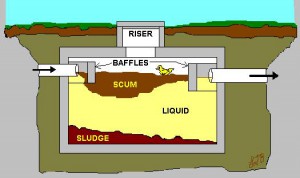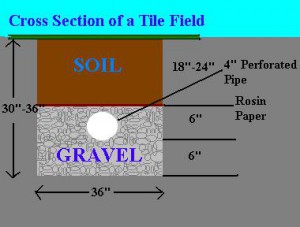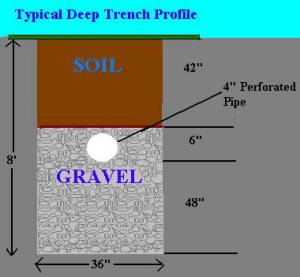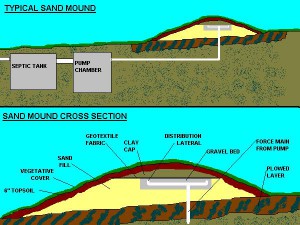Environmental Health – Sewage Disposal
Request Your Septic System Records
Individual On-site Sewage Disposal System (OSDS) Profiles
In many areas of Carroll County there are no public sewer systems to carry away household wastes. In such areas, individual septic systems are installed on each homeowner’s lot to dispose of the waterborne waste from the house. Though public sewerage is preferable, a well-designed, correctly constructed, and properly maintained septic system can, within its limitations, give a period of satisfactory service.
If you are planning a home that uses a septic system, be sure to discuss the design of the system with the Health Department to make sure it will meet your needs. This information does not provide criteria for constructing or planning a septic system. Each system should be individually designed to satisfy the needs of the specific home it is to serve.
A septic system (individual on-site sewage disposal system) may be built after a permit is issued by the Health Department. Before a permit may be issued, soil percolation tests must be made to determine the rate at which the soil can absorb the liquid to be discharged from the septic tank.
Yet, problems can occur. Conditions may change. The number of persons served by the system, the soil, or the flow of sewage may vary enough that the system will break down. This may happen even though the design and installation of the septic system was approved by the Health Department.
Lack of maintenance alone can cause a well-designed system to break down. For these reasons, no one, including the Health Department, can guarantee the continued functioning of any septic system, for these systems are limited in capacity and useful life. However, proper maintenance can help the homeowner prolong the useful life of a septic system and obtain the best possible service from it.
Since maintenance is essential, the homeowner should have a diagram showing the location of the septic system. This should show the location of the house, septic tank, distribution box (if there is one), pump pit (if there is one), effluent disposal area, and the water supply well. Ask your contractor to furnish such a diagram, obtain a copy of the sewage disposal permit, or have it drawn.
To maintain a septic system, you should know (1) what it is, (2) where it is, (3) how it works, and (4) when it should be serviced.
A septic tank is usually rectangular and made of concrete, though some concrete block and steel tanks exist. It is buried underground on the property of the home it serves. The tank is usually designed to retain for 24-36 hours the sewage that flows from the home each day. For this reason, some homes require larger tanks than others. The size of the septic tank is determined by the possible occupancy of the house and other factors. A larger tank allows for more extensive decomposition and usually gives better service.
SEPTIC TANK PROFILE
The top of the tank is usually fitted with a manhole or six-inch diameter clean-out pipes with covers that extend to the surface. Older septic tank installations often were buried completely, even though a clean-out hole with a cover was built into the top. There are many tanks of both designs in use. Sewage flows through the house sewer to the tank. The heavier solids settle to the bottom and decompose, forming a sludge. The lighter solids, greases, and fats rise to the surface of the liquid, forming a scum.
The center layer of liquid is water containing dissolved and suspended sewage material. It flows from the tank through an outlet pipe to a tile field, deep trench, sand mound, or seepage pit. The opening to the outlet pipe is submerged in the liquid below the scum layer to prevent this matter from entering the pipe. The tile field, deep trench, sand mound, or seepage pit are the second part of the system. These structures allow the liquid that flows from the tank to seep into the soil over a large area so this liquid may be absorbed into the ground.
Hints for Proper Septic Maintenance
With continued use of the septic tank, both the scum layer above the liquid and the sludge below it increase in depth. If the tank is neglected, one or both of these substances eventually can reach the outlet pipe and then enter the tile field, deep trench, sand mound, or seepage pit and clog the system. Complications also can arise if there is more liquid flowing through the system than the surrounding earth can absorb. Replacement of the system is often the only solution.
FOR BEST SERVICE THESE PRECAUTIONS ARE SUGGESTED:
- Become familiar with the location of the components of your septic system. Check your diagram.
- Do not allow motor vehicles to drive over any part of your underground system. The underground pipes could be crushed or broken, which could stop the operation of the system.
- Do not plant trees or shrubs on or near the system. Their roots may enter the fields and clog them.
- Do not overload your septic system. The septic tank should receive all wastewater from your house, including that from dishwashers, washing machines, and garbage grinders.
- Rainwater from downspouts, sump pumps, water from foundation drains or other relatively clean water should not be piped into your septic tank or disposal field. To do so could flood the tank, stir up the contents, and carry some of the solids or grease to the disposal fields, sand mound or seepage pit.
- For best service, cooking greases and fats should be poured into an expendable container that can be disposed of with the trash or garbage. If these substances are poured into a kitchen sink, they tend to cause trouble, since they harden in the sewer pipes and increase the scum layer in the septic tank.
- Check the level of solids in your tank once a year to determine if it needs cleaning. You can do this by following the steps in the back of this booklet in the section – “Checking Your Septic Tank.”
- Ask your Health Department about a list of licensed septage haulers, listed in the yellow pages of your telephone book under “Septic Tanks and Systems.” They are equipped to clean the solids and scum out of your septic tank. Failure to clean the septic tank when needed allows solids and scum to pass into the disposal field or seepage pit. The seepage area can then become clogged and force sewage to the surface of the ground or back into the house. This creates a hazard to the health of your family and neighbors. Also, when your septic system fails, sinks and toilets will not drain. Correction may be expensive. Some corrections require continuing expenditures of money.
- Flushing yeast or chemicals into the system will not reduce the solids in the tank; this is not a substitute for cleaning. If such products had value, the Health Department would be the first to suggest their use. The natural bacteria in the tank provide the most efficient cleaning method. On the other hand, the amounts of bleaches, cleaners, and drain cleaning chemical generally used are so small in relation to the septic tank capacity that they do not interfere with the operation of the system.
- When the tank is cleaned, a small amount of sludge should be left in it. This provides bacteria for the decomposition process.
- If you have any questions or problems, CALL YOUR LOCAL HEALTH DEPARTMENT. Their personnel will advise and help you in any way they can.
- PLEASE REMEMBER TWO IMPORTANT THINGS: The care and maintenance of your private sewage disposal system is your responsibility. Septic system overflow is human waste, which can carry disease, cause offensive odors, and attract flies. You need to prevent or correct breakdowns to protect your family and neighbors. When an overflowing private sewage disposal system creates a hazard to the community’s health, the Health Department must take action – often action against you. Second, remember that neglected systems can be very expensive to repair. The money saved by lack of maintenance is lost very quickly when replacing a failed system. If your system has not been checked within the past two years, it would be wise to do so.
How to Check Your Septic Tank
This can be done with improvised tools, one for checking sludge depth and one for checking scum level.
To check sludge depth, use a pole or 2×2 inch stud about eight feet long. Bind rough Turkish toweling around the pole for three feet from one end. Remove the manhole cover or clean-out hole cover nearest the outlet pipe. Break a hole in the scum layer with the pole. Press the towel end of the pole down through the liquid until resistance is felt. This is the sludge layer. Press the pole down through the sludge until the pole reaches the bottom of the tank. If the sludge depth is one-third or more of the liquid depth, cleaning is needed. Some authorities recommend cleaning when the sludge becomes one foot deep.
To check the scum level, use another pole or 2×2 stud about eight feet long. Nail a flat board about four inches square to one end. (The pole with the board attached should look like the letter “T”.) Push the end with the board attached through the scum layer and move it to one side into an undisturbed scum area. Lift the pole slowly until resistance is felt from the square board contacting the bottom of the scum. Put a mark on the pole even with the top of the access hole. Next move the pole until you locate the bottom of the outlet pipe or baffle. Lift the pole so the square board hooks onto the bottom of the pipe or baffle. Again mark the pole even with the top of the access hole. The mark showing the bottom of the scum should always be above the mark showing the bottom of the outlet pipe or baffle. Cleaning is needed before the scum becomes deep enough to go under the outlet pipe or baffle.






